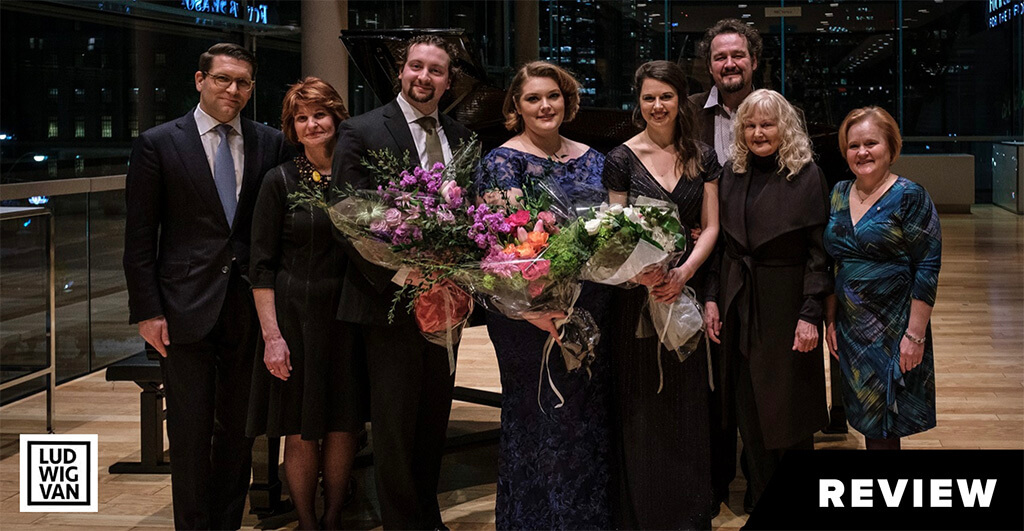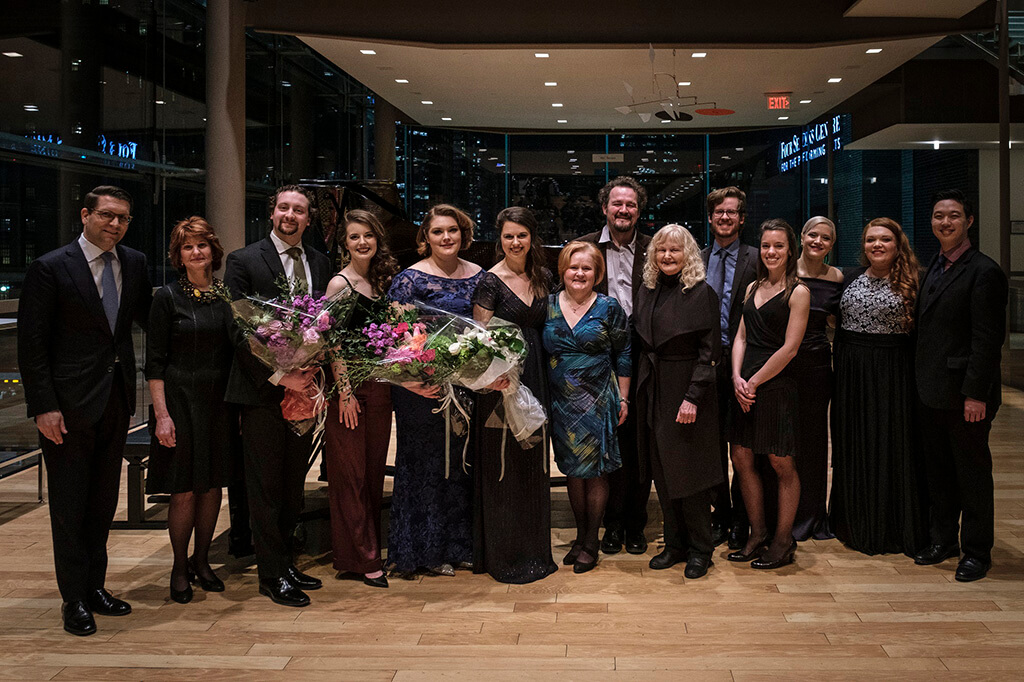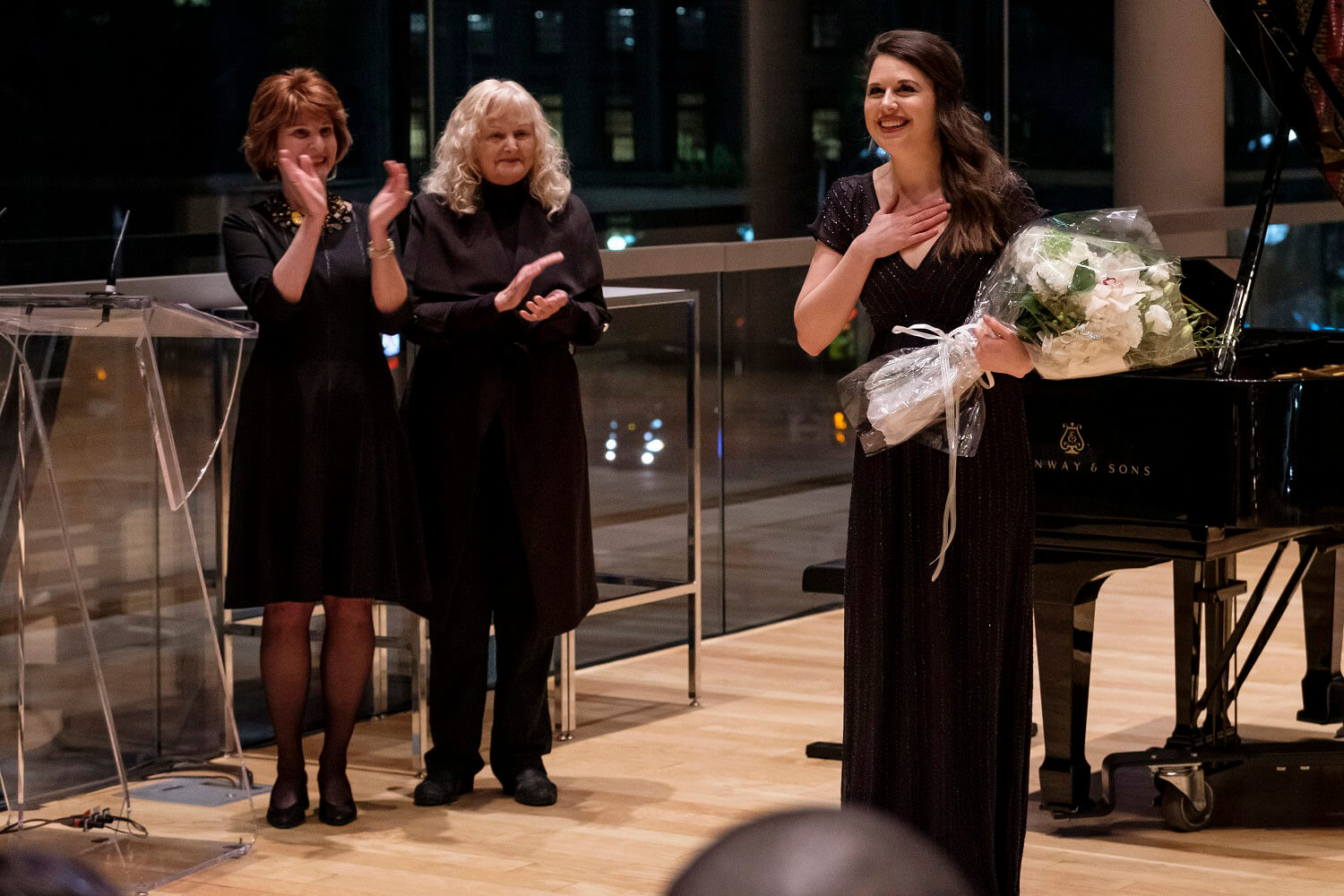
Simone McIntosh, mezzo; Lauren Margison, sop.; Samuel Chan, bar.; Simona Genga, mezzo; Joel Allison, bass-bar.; Lauren Eberwein, sop.; Anna-Sophie Neher, sop. Rachael Kerr and Stéphane Mayer, pianists. Alexander Neef, Tracy Dahl, Russell Braun. Richard Bradshaw Amphitheatre, Four Seasons Centre, 5:30 p.m., Feb. 11, 2019.
One of the pleasures of following the Canadian Opera Company is a chance to hear up and coming singers in the COC Ensemble Studio. Since its inception in 1980, the Ensemble has nurtured many Canadians who have gone on to significant careers — among them Ben Heppner, John Fanning, Isabel Bayrakdarian, Wendy Nielsen, and in more recent years Joseph Kaiser, Philippe Sly and Gordon Bintner, to name a few.
As members of the Ensemble, the singers (and pianists) earn a salary, benefited from the best coaches in the business, and a chance to get their feet wet as professionals on the mainstage. Occasionally, one of them would get lucky and be assigned a principal role, but mostly they sing the supporting roles while covering the leads, and spend their time honing their craft before venturing into the opera world flying solo.
Events such as the Christina and Louis Quilico Awards give audience members a great chance to hear and see what these young artists can do. Here they sing meatier repertoire that we normally won’t hear from the anymore, now that the “ensemble show” on the mainstage is a thing of the past. The 2018-19 Ensemble is a very strong group. All the singers possess fresh, beautiful voice, solid training, youthful enthusiasm, and most importantly the desire to communicate their art to their audience.
As competitions go, the Quilico Awards is relatively straightforward, given it’s essentially an “in-house” competition. Each candidate sings an aria of his/her choice, and the jury get to request one from the list of three submitted by the candidate. On the piano this year are two excellent and experienced Ensemble pianists, Rachael Kerr and Stéphane Mayer.

Mezzo Simone McIntosh kicked off the proceedings with Tamiri’s aria, “Di tante sue procelle” from Mozart’s Il re pastore. This is high mezzo territory, although in Mozart’s day, such a voice type didn’t exist but was generally classified as “soprano II.” McIntosh, a high mezzo with lovely sheen to her tone and excellent facility at the top, sang the aria with gleaming tone (if with a hint of metal at the top) and an engaging stage presence. The jury requested the Komponist’s aria from Ariadne auf Naxos, which was perfect for her. An excellent start!
Next up was soprano Lauren Margison. I recall her first appearance at the RBA quite some years ago – as a folk singer! Lauren’s father is well known Canadian tenor Richard Margison, who had a background in folk music. Now the daughter has gone into opera, trained by her dad, to great results. Her Fiordiligi’s “Come Scoglio” and the subsequent Liu’s aria showed off her lovely tone and secure technique. The Cosi aria is fiendishly difficult, as if Mozart is poking fun at Fiordiligi. Margison sang both aria beautifully, albeit a bit too forcefully on the two high Cs. Her mezza voce was gorgeous.
Baritone Samuel Chan was up next, offering Guglielmo’s aria “Rivolgete a lui lo sguardo.” His is a compact-sized, warm, naturally produced high baritone, backed by a solid technique. He offered vivid acting in this comic aria without a trace of self-consciousness, not easy in a recital. He followed up with the Tower Scene from Pelleas et Melisande. Pelleas is a “baritenor” role, and the complete Tower Scene with its 20 minutes of intense singing, not to mention a high G, is very taxing. Only part of it was excerpted and Chan sang it beautifully.
The first half ended with first-year Ensemble member mezzo Simona Genga who began with Charlotte’s great scena from Werther. Hers is a smooth, gleaming mezzo with a lovely timbre. I liked her Charlotte’s aria very much. It’s perhaps not as showy an aria, but it builds to a heart-wrenching climax, and Genga handled it well. I must say I was surprised to find “Du bist der Lenz” on her list. While Sieglinde’s tessitura is low, but it’s still considered dramatic soprano territory. Genga showed that she certainly has all the notes and is a creditable Sieglinde, a slightly pushed top note at the end notwithstanding.
The second half opened with bass-baritone Joel Allison and Nick Shadow’s “Come Master” from The Rake’s Progress. Allison has a rich, ringing bass-baritone with a solid core and an easy top, which allows him to tackle the Diamond Aria with ease. If his Nick Shadow was impressive, it didn’t prepare me for his “Fra l’ombre e gli orrori,” Polythemus’s aria from Handel’s Acis, Galatea e Polifemo. This aria is well nigh impossible vocally given its extreme range, from low D to high A. A very slow aria, which means all the notes have to be sustained. Allison sang all the notes as written, and with distinction. Bravo!
Next came mezzo-turned-soprano Lauren Eberwein, who began with “Vissi d’arte.” One rarely finds this showstopper in vocal competitions. Eberwein sang it with attractive if slightly cool timbre, only falling a little short on the quality of her parlando. The big surprise was Elisabeth’s “Dich teure Halle.” Eberwein cool timbre is in many ways ideal in German operas, and overall she sang it very well, a few fleeting moments of flatness at the top notwithstanding.
The final singer was lyric-coloratura Anna-Sophie Neher. Her gleaming tone and excellent agility were very much in evidence in Comtesse Adele’s dynamite “En proie a la tristesse.” This is quite a long aria, but she held the stage very well, singing with sparkling tone. The session ended with Sophie’s music in Presentation of the Rose from Der Rosenkavalier.” I’ve always found it odd that this duet is excerpted as a solo for the soprano – I keep expecting Octavian to come in! No matter, Neher sang it beautifully, with the requisite pure, crystalline tone, all the way up to a C sharp.
There you have it — seven singers, all very talented, well trained, in possession of beautiful voices, and the potential for significant careers if they continue to grow. The jury panel retired to deliberate. It took about 25 minutes, and they returned with the verdict: Anna-Sophie Neher (First Prize of $8,000), Joel Allison (Second Prize of $4,000), and Simona Genga (Third Prize of $3,000). While it’s true that some are more ready for prime time than others, I do feel that they all sang very well. In my book, they’re all winners. Congratulations to the winners, and I look forward to hearing them again in the future.




